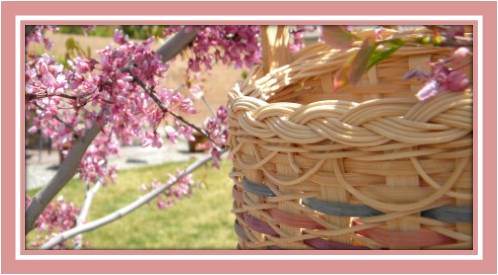 I am the Basketry scouting merit badge counselor in our area. Two of the baskets that the scouts need to weave are a round basket and a square basket. There are kits available for the scouts to weave, but ok, I'm not happy with them. If these kids are going to weave, they are going to weave something that looks nice and something that they will be proud of. I wanted to offer a few tips with regards to teaching children to weave.
I am the Basketry scouting merit badge counselor in our area. Two of the baskets that the scouts need to weave are a round basket and a square basket. There are kits available for the scouts to weave, but ok, I'm not happy with them. If these kids are going to weave, they are going to weave something that looks nice and something that they will be proud of. I wanted to offer a few tips with regards to teaching children to weave.Generally speaking, I prefer the children to be at least 13 years old. In working with the scouts, they are sometimes a year or two younger. If that is the case, I personally don't teach more than 4 young scouts at a time. If they are 13 or older, I will teach a class of 6 or 7. Children just need more help than an adult needs so I find it best to keep my class size smaller. My preference is for children to be 13 just because younger children might not have the hand dexterity to weave. Also, younger children just have a shorter attention span and can become easily frustrated if the basket is not coming together like they think it should.
I always start with the square basket. I find that twining can be a bit more confusing so with a square basket there is less twining. Usually what happens is that they will do a 'chase weave' with their round reed rather than twining. If the children, especially the younger ones, are happy with the chase weave, then I leave it and let them know they've done a different type of weaving which is just fine and let them know what a great job they did with the chase weave. If it is caught quickly, I gently correct the mistake and show them proper twining technique.
I have them cut their spokes and stakes from 5/8" flat. Since it is wider, they can weave a bigger basket in a shorter amount of time. I keep the weavers at 3/8" flat except for the rim row being 1/4" flat.
I keep the baskets small. For the square basket, they cut 10 stakes. 5 are horizontal and the other 5 woven in vertically. For the round basket, we cut only 5 spokes.
I like a woven rim and think that is important to teach this. For the outside of the rim I use 3/8" flat/oval and for the inside of the rim I use 3/8" flat. Normally I would always use flat/oval on both the inside and outside of the rim, but that gets thick and harder to manage. It is much easier for children to use flat reed on the inside. You could use flat reed on the outside of the basket as well, but again, I just don't care for the look and I want the children to be happy with their basket.
When lashing the rim in place we only go around the basket one time. We cut a lasher that measures 2 1/2 times around the basket so we are sure to have plenty yet it is not so much that it is difficult to manage.
I always encourage the use of plenty of clothespins as they are our extra helping hands.
I always give lots of praise so that no matter what their basket looks like, those kids think they created a masterpiece. I encourage their scout leader to take pictures of the children with their basket. I also talk to the children about what they are going to use their baskets for. If they don't know what to use it for, I let them know that their mother would just L-O-V-E it.
I have bright colors of dyed reed on hand and I let them pick what color or colors they would like to use.
I have snacks and drinks on hand. Basket weaving is hard work for these little ones and sometimes they need to step away from their project for just a bit. Allow three hours to teach just one of these simple baskets. Three hours is a long time for a child and they need a break. Depending on the ages of the children, if they are younger, consider breaking the class up over two days. What I find is that they children get impatient to finish the basket and then they start to get sloppy with their work. That's when it is time to take a break, have them run outside, or stop the class and continue it another day.
Never ever, EVER discourage a child. If they are struggling say, "You are doing a great job. I like how you did this or that with the basket, but would it be ok if I show you how to do this just a little better." Sometimes you even need to get behind the child and place your hands on the child's hands and show them exactly what you mean. What we say as adults and what children hear are two different things. We may think we are perfectly clear in our explanations, but to a child learning something new it is like we are speaking a foreign language. Many of the words we use in weaving are new to children so don't expect them to remember what the words mean right away.
 This next bit really isn't a book review, but I wanted to show you something that was on my bookshelf. It is a self-published book titled, "Basket Making with Kids" by Vicky Teich. This book has several contributing pattern writers and gives a number of good tips for weaving with children. The tips above are all mine, but I do overlap in some of the tips that are given in the book. It also has the instructions for the baskets shown in the photo. The photo is glued onto the front cover and there are notes in the book that are hand written. I love that. This book was put together without a computer! I do think that the basket patterns in the book are very sweet, but I find that they are geared more to the older child. If you wove them with a younger child, say age 12 or 13, you might have to teach them one on one or at least have a very small class, or have their parents stay for class and assist their child. One of the patterns mentions shaving some of the flat/oval. Giving children a knife to shave with requires very close supervision.
This next bit really isn't a book review, but I wanted to show you something that was on my bookshelf. It is a self-published book titled, "Basket Making with Kids" by Vicky Teich. This book has several contributing pattern writers and gives a number of good tips for weaving with children. The tips above are all mine, but I do overlap in some of the tips that are given in the book. It also has the instructions for the baskets shown in the photo. The photo is glued onto the front cover and there are notes in the book that are hand written. I love that. This book was put together without a computer! I do think that the basket patterns in the book are very sweet, but I find that they are geared more to the older child. If you wove them with a younger child, say age 12 or 13, you might have to teach them one on one or at least have a very small class, or have their parents stay for class and assist their child. One of the patterns mentions shaving some of the flat/oval. Giving children a knife to shave with requires very close supervision.Don't be afraid to teach children. I promise your heart will shine as you watch the expression on a child's face when they complete their first basket.
Baskets of Blessings,
Nancy





2 comments:
You sound like an excellent teacher. I think the first skill a teacher needs is to recognize the skill level required to learn. Nothing is more discouraging that not being able to do something. Blessings
QMM
I sure wish that there were someone nearby with a ministry such as yours. I would love for someone to be able to share such a creative and useful talent with my children.
I received both of your comments and I am encouraged to know that there are still women who understand the strength and power demonstrated from a submitted wife.
Thank you for your encouraging comment Nancy.
Post a Comment